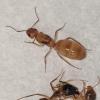So I recently caught a Camponotus nearcticus dealate and am looking forward to seeing her first nanitics. If anyone has has any experience or tips keeping this species please tell me. Thanks!
- Formiculture.com
- Forums
- Gallery
- Members
- Member Map
- Chat

So I recently caught a Camponotus nearcticus dealate and am looking forward to seeing her first nanitics. If anyone has has any experience or tips keeping this species please tell me. Thanks!
I have 4 Camponotus cf. nearcticus queens/small colonies colonies that are doing well for me. Their brood develops faster than the larger Camponotus species. The 2 colonies I have are so small though (1-2 workers) that I can't tell if they are drinking the sunburst ant nectar I've given them. My guess is probably.
I have a colony that I got from a log back in August of last year - they like a dry nest and like a heating pad up to i'd say 80ish degrees. On hot days they do move away from the heating pad but when it cools down they move back under it.
I've fed them wax worms/mealworms/crickets/fruit and they seem to like them all. For sugars they seem to like honey or apple jam - I also gave them a piece of caramel corn that they also enjoy.
The colonies are on the smaller side I think - they are sitting at probably right around 100 and the brood is growing fairly slowly.
So for C. nearcticus, how big do the colonies get? What size formicarium would be the best?
Their maximum colony size, according to what researchers found on wikipedia, is about 530 but most had 100-300 in them. A small formicarium should be enough space for them.
If you plan on updating I'd recommend starting a journal, also pictures!!
 |
Market Place →
General Market Place →
Georgia - All must go!Started by sanlefa , Yesterday, 4:26 PM |
|

|
|
 |
Anting →
Ant ID Requests →
Camponotus ID North TexasStarted by AntsTx , Mar 15 2025 |
|

|
|
Anting →
Ant ID Requests →
Camponotus ID, Whitney TXStarted by AntsTx , Feb 3 2025 |
|

|
||
Ants & Myrmecology →
General →
Best THA Decor Style for Camponotus pennsylvanicusStarted by AntsTx , Nov 27 2024 |
|

|
||
 |
Ant Keeping →
Ant Keeping Journals →
Woodland Giants (Camponotus Ca-02)Started by AntsGodzilla , Nov 16 2024 |
|

|
0 members, 1 guests, 0 anonymous users